Dear creative friends,
Welcome to Issue No. 64 of the Studioworks Journal. As we step into a season of renewal, our focus, this month, turns to the enchanting world of Botanical Art. This issue explores how the timeless practice of botanical illustration can enrich our creativity, connect us with nature, and enhance our well-being and mindfulness.
Spring's arrival, with its fresh blooms and new life, inspires us to reflect on our own growth and creativity. I’ve curated content that bridges traditional botanical art with modern expression, offering insights into how this art form can be a meditative tool for personal and artistic development.
May this issue inspire you to explore the natural world and infuse your creative practice with new vitality!
Grab a cup of something cozy and dive in with me!
xo,

So you may be wondering, where do I start? To that, I say, wherever feels right to you. Each month we will have a theme, a creative affirmation, a power word, a color palette, sketchbook exercises, art projects, articles, recommended reading, and access to wonderful inspiration and resources. I want you to think of this as a delicious new magazine, you know the ones you occasionally splurge on, with soft, velvety pages, beautiful images, and inspiring content!
Each issue will invite you to explore your creative practice in whichever way works for you. Experience each issue at your own pace. Take what resonates with you and put the rest aside for another time.
Grab a cup of something lovely and dive in.
Humans and plants have always been inextricably woven together in the dance of life. They nourish us, inspire us, and beautify our world. We cultivate them, nurture them, and when we’re in balance, enhance their ability to thrive.
Because our destinies are interwoven, botanical themes have run through our art from the very beginning of human creative expression. These representations have ebbed, flowed, and evolved over time but have seldom diminished in popularity for long. Join me in exploring botanical art's origins and fascinating meanderings.
Pinpointing the oldest piece of art of any kind is a tricky business. However, arguably, the oldest depiction of a plant is a 25,000-year-old cave painting found in Serra da Capivara, Brazil, of what appears to be male figures worshiping a tree. Regardless of whether it’s truly the first, this representation reveals early humans’ great reverence for plant life, demonstrating our essential relationship.
Since then, plant art globally has had a long and rich history. However, some cultures have not only made plants central to their lives but also produced prolific artists and left much to posterity. Among these, Egypt, Greece, and Italy deserve honorable mention.
More than 4,000 years ago, plant art was making a splash in Egypt and Mesopotamia. Every facet of Egyptian life incorporated botany, from food and medicine to perfumery, religion, and beyond. Their extensive herbal knowledge and remedies survived the passage of time and now comprise much of contemporary alternative medicine.
Rightfully, the combination of beauty, healing properties, and sustenance imbued plants with sacred meaning, earning them a central role in Egyptian culture and prevalence in their art. Coins, carvings, wall paintings, and prints all featured plants. Often, the depictions included the god or goddess with whom the particular plant was associated.
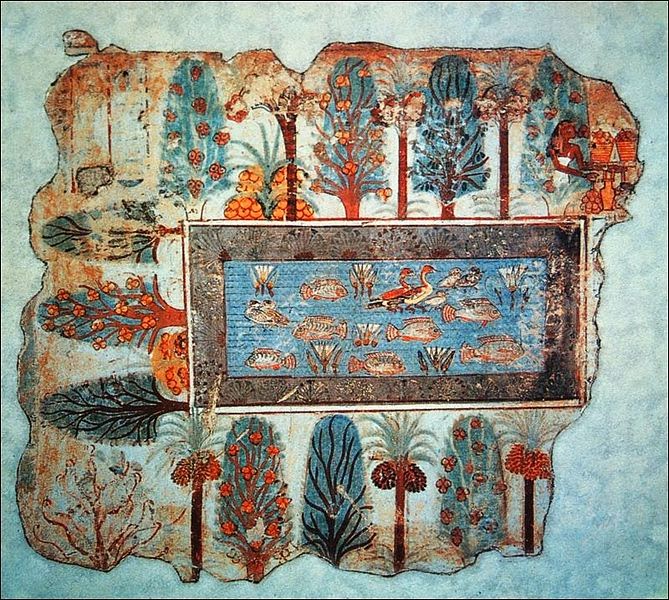
A garden fresco from the tomb of Nebamun, British Museum showing sycamore figs, date palms, doum palms, persea trees, mandrakes and a pond full of lotus plants, fish and geese
As with many other foundational aspects of Western culture, the Greeks took botanical art to the next level. Works such as Aristotle’s De Plantis and Pedanius Dioscorides’s De Materia Medica were pivotal in creating the more scientific branch of plant art, botanical illustration. Beginning in the 7th century BCE, a significant shift occurred, marking the Greek Geometric period's end and the Archaic period's commencement. Greek artists were heavily influenced by their neighbors in Egypt and the Near East, and naturalist themes such as the palmette and lotus compositions became central.
The Greeks elaborated on the ideas of their neighbors, depicting scenes that reflected their own mythology and customs. These pieces laid the groundwork for Classical Greek Art with its enduring influence. The artistic centers of Athens, Sparta, and Corinth each contributed their particular regional flare, from vase paintings, ivory carvings, and bronzes to silhouetted forms applied to various surfaces with tapestry-like patterns of plants and animals. In fact, all conceivable surfaces, from freestanding stone sculptures to building reliefs, were used to exhibit plant motifs.
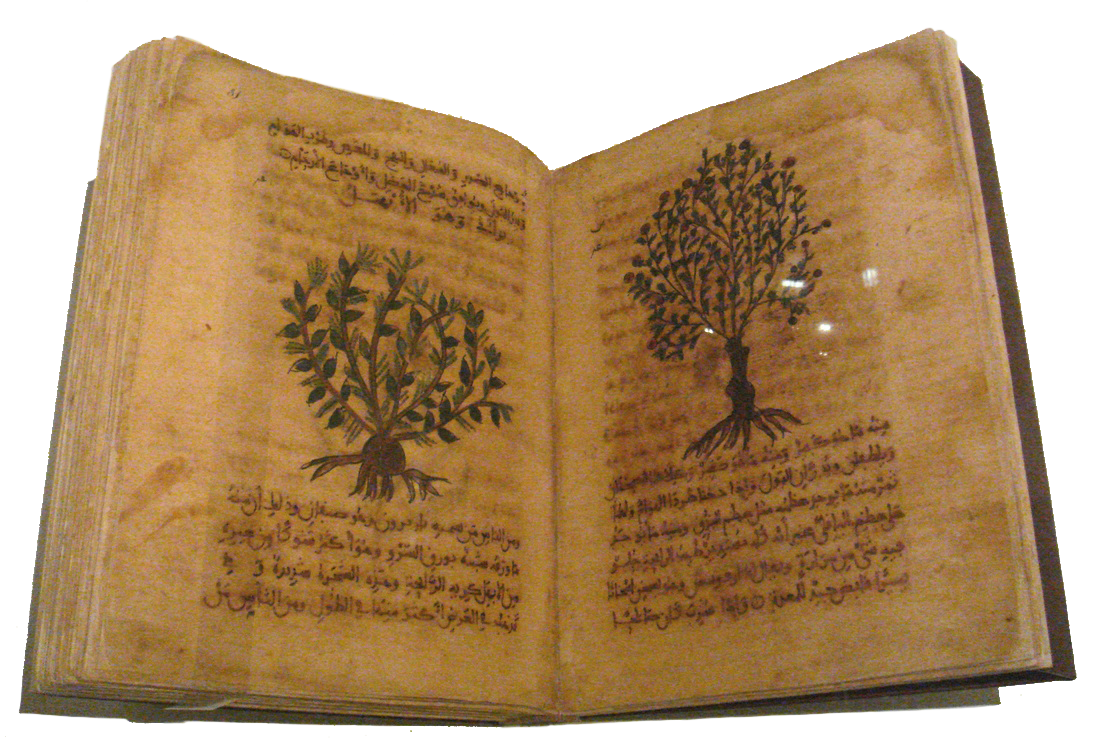
De Materia Medica by Dioscorides - Spain 12th 13th century
In the first century A.D., Pliny the Elder began creating extensive botanical illustrations to identify and record plants. Pliny’s seminal work Natural History devoted books 12-27 to botany within its 37 volumes, oftening referencing Aristotle’s De Plantis. The reverence of, and influence by, Greek artists and thinkers amongst Romans is a recurring theme in their art and literature.
Throughout history, plants have featured widely in Italian frescoes, mosaics, books, and textiles. However, a particularly vibrant period of botanical art flourished between the 16th and 18th centuries. Under the patronage of the Medici grand dukes, Florentine artists married the sciences of botany and horticulture to art in their enduringly beautiful interpretations of the natural world.

Botanical drawing by Leonardo Da Vinci
Though botanical subjects have been a focus of art since its inception, specific periods have generated high volumes of impressive plant-based imagery. The Renaissance transformed the field of botanical art due to the emergence of increased scientific precision and artistic sensibility, as demonstrated by the likes of Leonardo Da Vinci and Albrecht Dürer. In addition, this period cemented the use of botanical illustration as a tool for scientific inquiry and record while imbuing the practical with elegance and beauty.
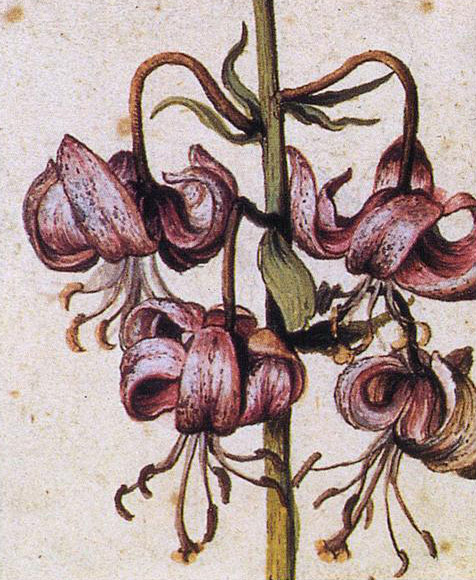
Lillium Martagon (Details) by Albrecht Durer
Another era that experienced a proliferation of botanical art was the Age of Exploration in the 17th and 18th centuries. During this period, no respectable expedition could transpire in the absence of a naturalist to catalog newly encountered flora and fauna. Naturalists would create a herbarium of pressed plants and meticulously dissect, study, and paint, usually in watercolor, detailed images of their findings. The result is a veritable bloom of incredible, thorough work that continues to evoke awe and wonder in the viewer.
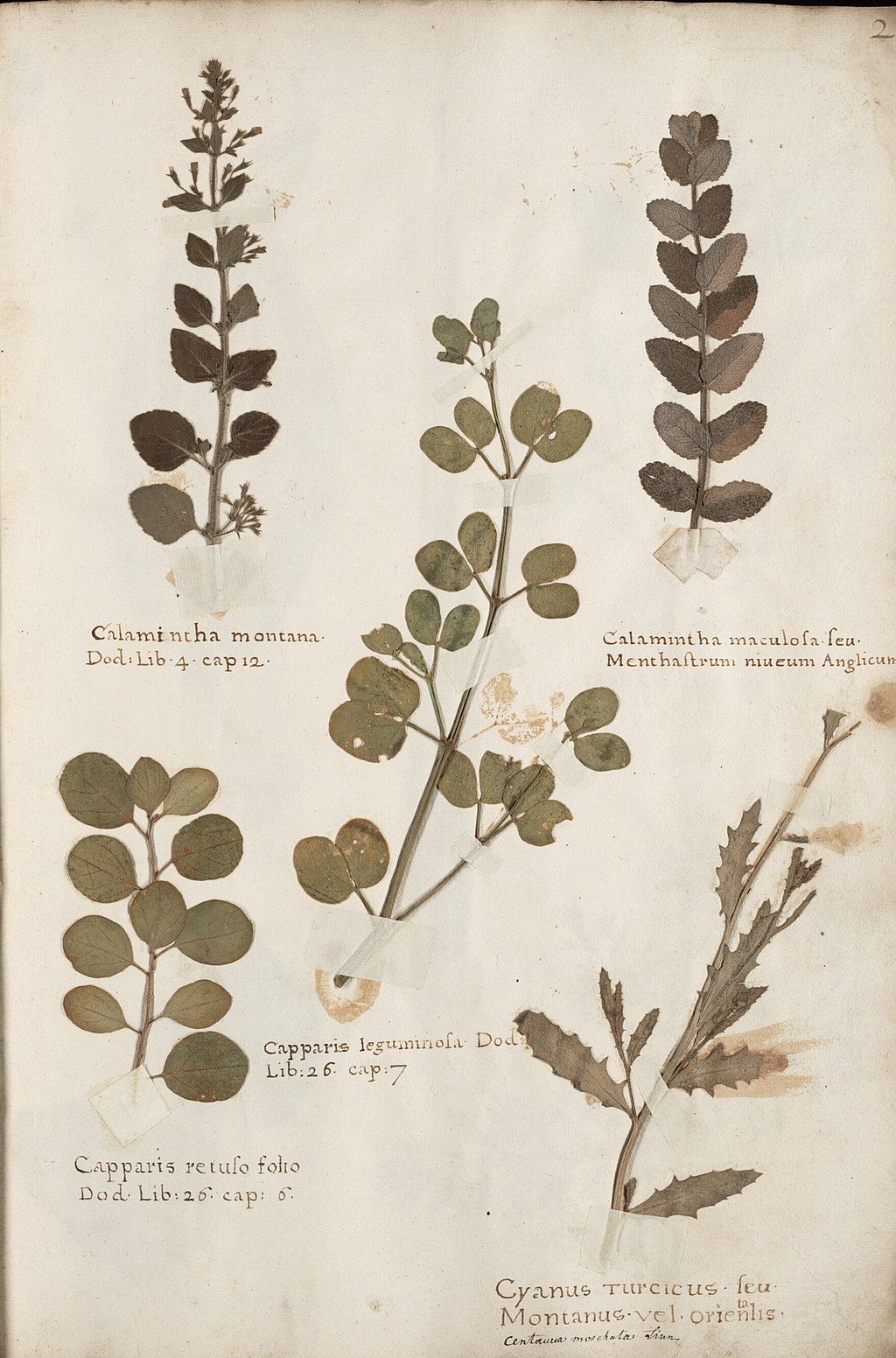
Herbarium book which dates from 1633. Made by the Flemish Bernardus Wynhouts
As the domain of plant art became increasingly dominated by a scientific angle, the field became, for all intents and purposes, an impenetrable boys’ club. However, art and scientific inquiry were passionately pursued by certain intrepid women who paved the way for future generations of female artists.
Among this category's greats are Maria Sibylla Merian, Elizabeth Blackwell, and Marianne North. Maria Sibylla Merian, born in Frankfurt to a Swiss family in 1647, was a Naturalist, Entomologist, Explorer, and one of the best botanical artists ever to grace the earth. Amongst her claims to fame is that she was one of the first naturalists to study insects extensively. Her classification of moths and butterflies is still used today.
Elizabeth Blackwell, born in London in 1699, was one of the first artists to draw, etch, and engrave her own designs. She also published a book called A Curious Herbal, which was the first compendium of medicinal plants in England. It comprised hand-drawn, engraved, and colored illustrations of plants and herbs depicting their healing properties. None other than the progenitor of taxonomy, Carll Linnaeus, referred to her as Botanica Blackwellia.
Marianne North, born in London in 1830, was an extensive traveler and painter of plants. She traversed the globe alone, replete in Victorian dress and, in keeping with her divergent behavior, painted in oils. She completed 832 paintings in her lifetime and donated the lot of them to Kew Gardens, where she financed a gallery to house them. Her contributions to botanical knowledge are commemorated in the genus Northia. Another nod to her talent came from Charles Darwin, who, after viewing her paintings of Australian plants, commented, “It was extremely kind of you to bring call up with considerable vividness scenes in various countries which I have seen, and it is no small pleasure; but my mind in this respect must be a mere barren waste compared with your mind.”
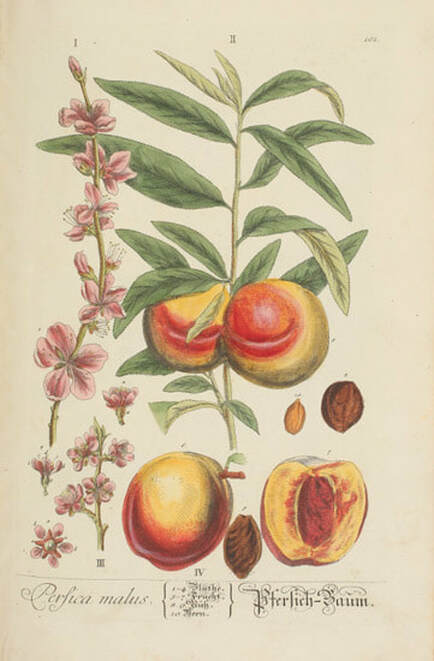
Perfica Malus (The Peach Tree) - Plate 101 by Elizabeth Blackwell
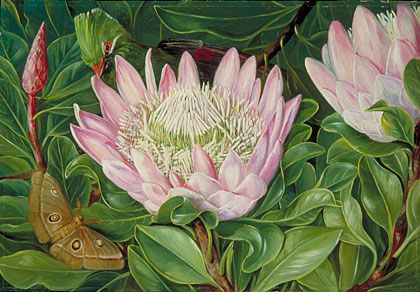
Not one Flower, but many in one, Van Staaden's Kloof by Marianne North
Botanical art has a storied past, reflecting the dynamic relationship between humans and plants. As long as people have been making art, they have beautified their work with flowers, fruits, and foliage. Plants are an endless trove of inspiration because they are not only lovely to behold, intricate, and gorgeous in design, but they also provide food, medicine, and nourishment for the soul.
Possessing an enhanced sensitivity to the world at large is a powerful tool for an artist. Using this sensitivity to tune into each of our senses and closely observe nature opens the door to infinite sources of inspiration. We have only to look closely at a single leaf to be filled with awe over the perfection of its design.
Whether we elect to recreate what we see in as exact detail as possible or produce general impressions and moods, our creative practice will gain much from the study of plants. This is particularly true if we also dive deeper into the vast cultural significance beyond the aesthetic that plants and flowers represent. Let’s explore some ways that we can incorporate botanical themes into our work and, in so doing, discover how our earth is an ever-accessible and perennial muse.
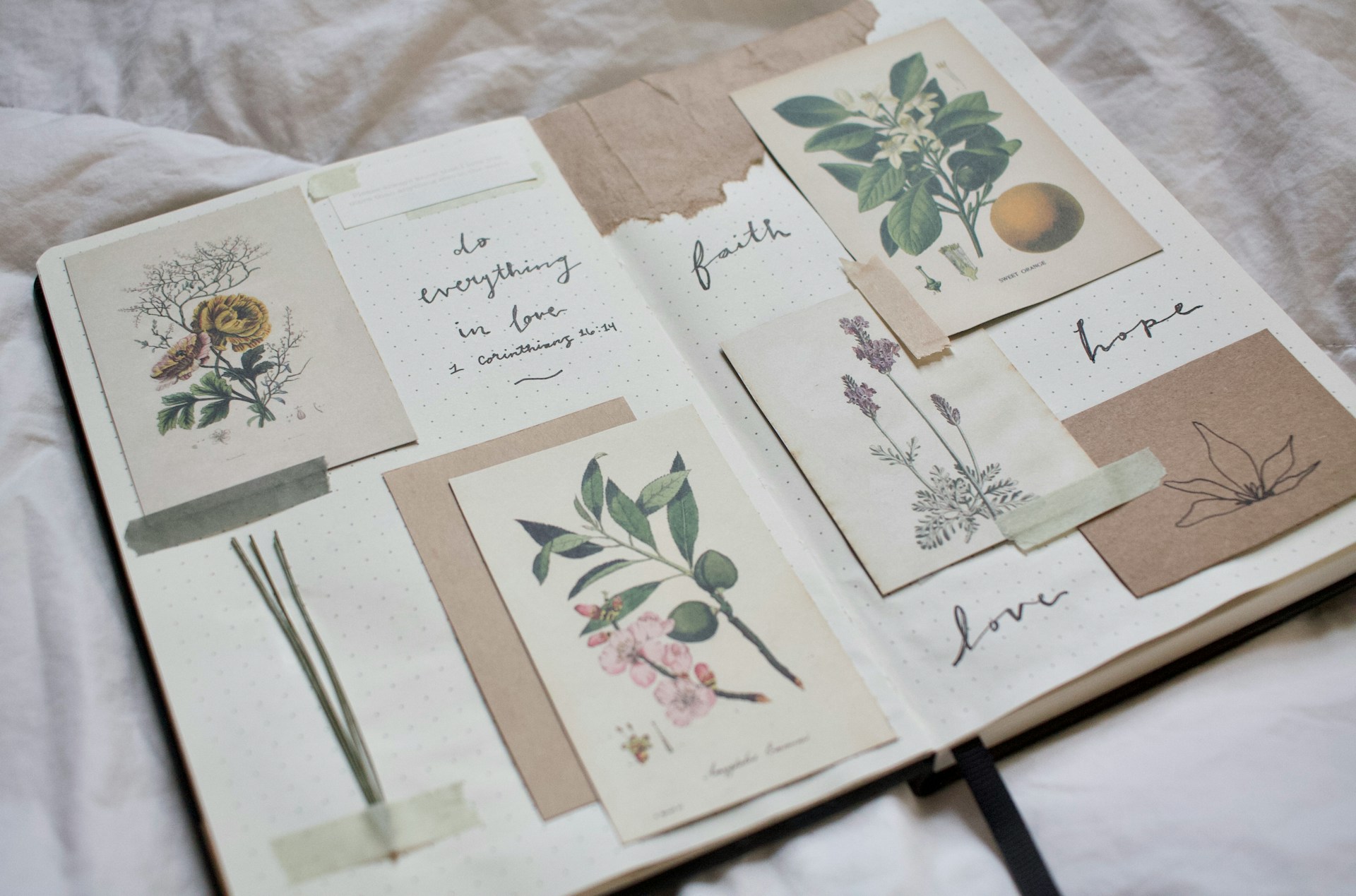
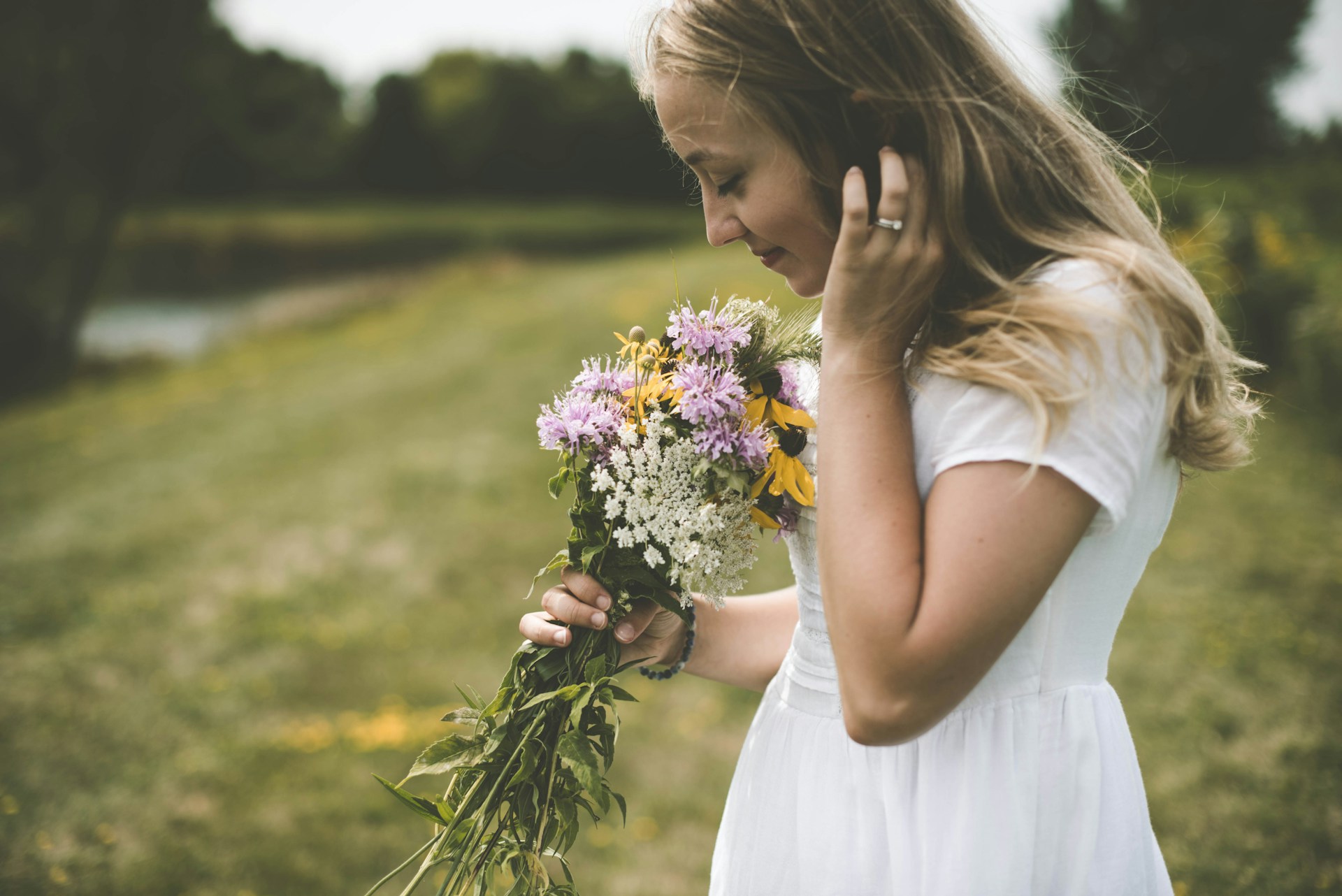
A plant or flower alone is already a perfect expression of beauty. Still, because they have unique fragrances, properties, uses, colors, time, and location of emergence, they are also a rich source of symbolism and meaning. Most folk traditions have an extensive language of plants, and many cultures have long used this language to send messages to friends, foes, and lovers alike.
A fine example of this is floriography, the often secretive or cryptological language of flowers, which has been a part of traditional culture for thousands of years across Europe, Asia, and Africa. During the Ottoman Empire, Turkey contributed significantly to the language of flowers via their game of Sélam, in which flowers and objects were gifted, and rhymes were included to reveal hidden messages.
The Victorian Era brought floriography to a new height, using flowers, especially during courtship, to express otherwise socially inappropriate sentiments. The language of flowers was a popular hobby in Britain during this period, and many people thoroughly devoted themselves to studying floral symbolism. Meaning could be found in every tiny detail. For example, a flower given with the right hand meant ‘yes,’ while one offered with the left hand meant ‘no.’
The color of a flower also had significance. Yellow meant friendship and happiness. Red signified affection, passion, and love. White represented innocence, humility, and purity. Pink evoked joy, grace, and innocence.
The type of flower and combinations of flowers also held particular meaning. For example, periwinkle and acacia were given to represent blossoming friendship, whereas honeysuckle symbolized sweetness and the bonds of love.
In art, flower symbolism has appeared repeatedly over the centuries. In many Anglican churches, there are depictions in stained glass, statuary, and paintings of Christ on a lily crucifix or holding a lily, which signifies purity. In paintings, such as John Everett Malais’s Ophelia, the natural landscape is gorgeously depicted, and the inclusion of a red poppy is used deliberately to represent sleep and death. Examples like this abound, adding rich meaning and intentionality to great artistic works.
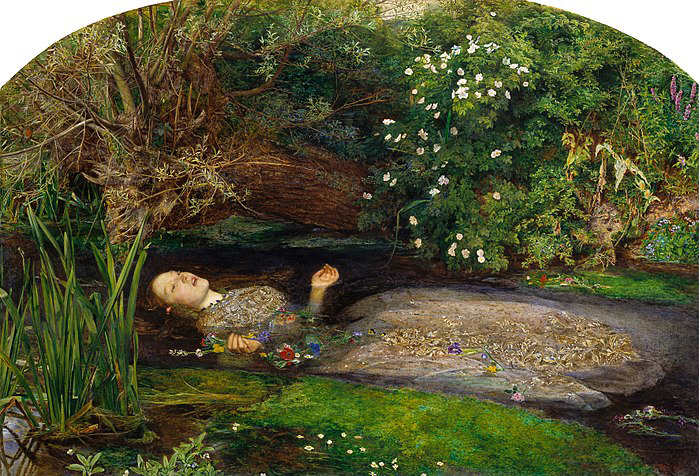
John Everett Malais
Ophelia 1851-1852
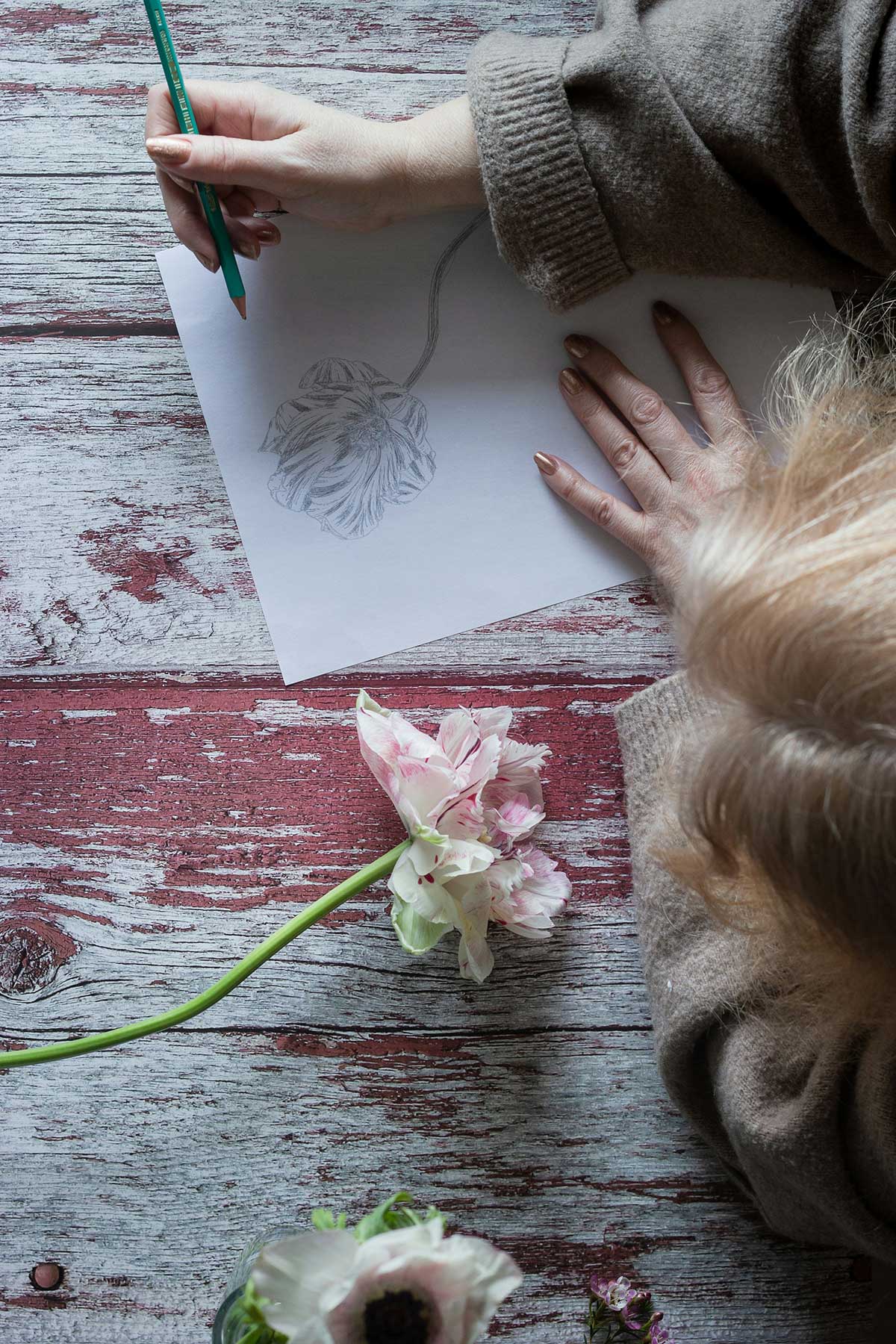
To make the most of our botanical subjects, it pays high dividends to be a patient and careful observer. Close inspection reveals the world within a blossom, and taking the time to explore these tiny universes does much to edify us as artists. Examining the work of master botanical illustrators demonstrates just how far this practice can go, making a visually stunning science of art.
In our own practice, we can learn from the masters and devote ourselves to the exploration of our subjects, viewing them from all angles and across their lifespan. Knowing a particular plant from seed to shoot, maturity to decay, deepens our perspective and enhances our appreciation for the miracle of life.
Make it a study or let it be play. The key is finding something that fascinates you and letting your curiosity take rein. Ask questions and allow your observations to reveal answers. Make the effort to cultivate a space where you can relax and open yourself to wonder. Through this practice, you will find inspiration everywhere you turn.
A flower isn’t just a flower; it can be a source of beauty, food, medicine, and a vessel for conveying particular sentiments. Incorporating plants into our art provides an opportunity to tap into longstanding cultural meanings as well as to represent our own spin on their significance. The mindful observation of living things is an avenue for discovering more about our world and ourselves. Nature is a playground for the imagination; the more we enjoy her, the richer our art becomes.
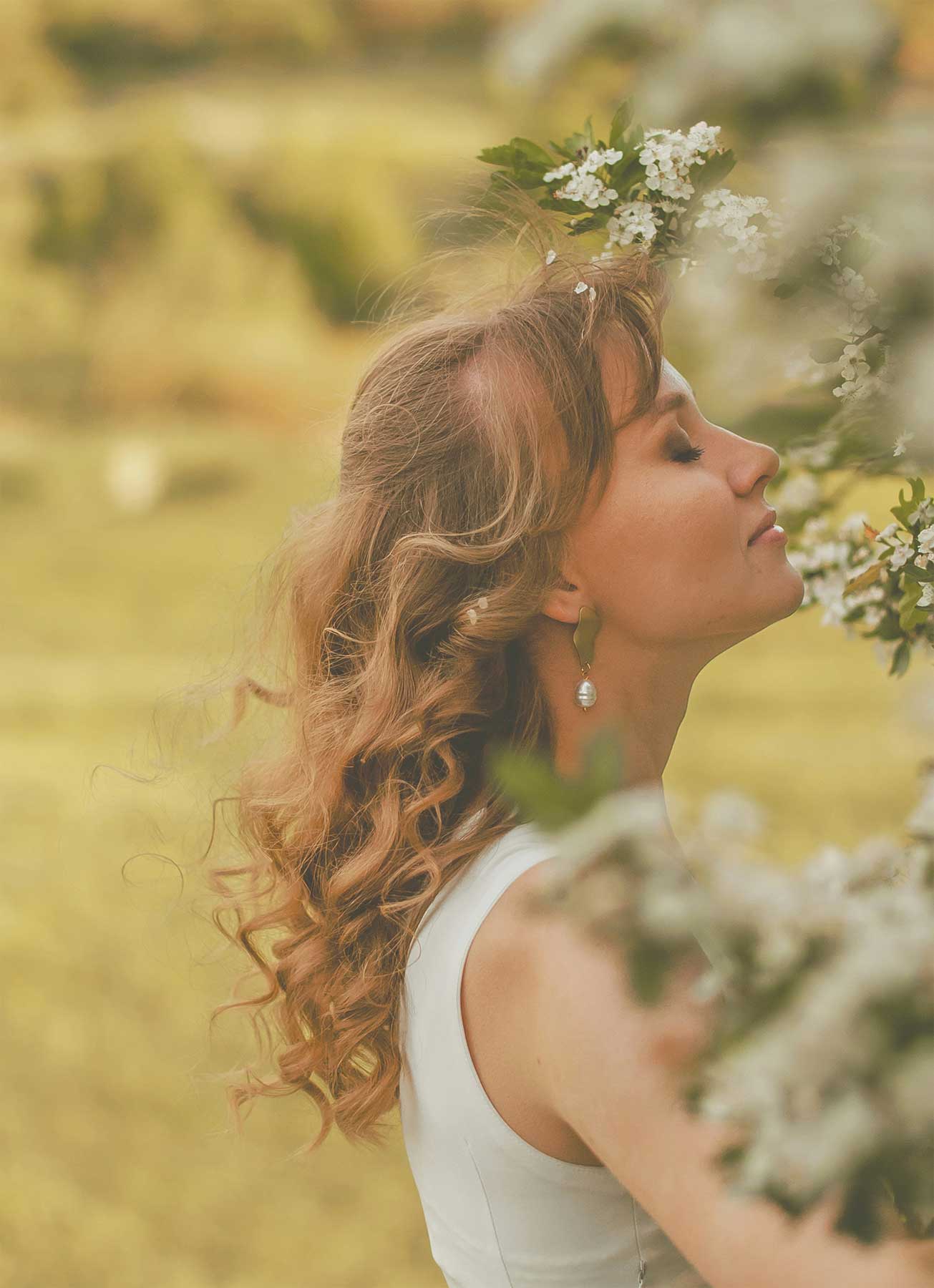
The dictionary definition of "awaken" is typically twofold, encompassing both a literal and a figurative sense:
Literal Definition: To stop sleeping; to wake up from sleep.
Figurative Definition: To become aware of something; to come into realization or consciousness of something; to rouse from a state of inactivity or dormancy.
So, how does this word relate to us and our theme this month?
• Renewed Perception: Just as awakening from sleep brings a person into a state of consciousness, us artists might "awaken" to new insights, perspectives, or inspirations that had previously been unnoticed or dormant. This can lead to fresh ideas and innovative approaches in our work.
• Revitalization of Creativity: To awaken might mean to rekindle a passion or interest that has lain dormant. This could be a return to a medium, subject, or style of work that once moved you but was set aside for other pursuits or due to creative block.
• Awareness of Surroundings: In a more literal sense, awakening to the world around us can mean becoming more observant of the details, patterns, and beauty in our environment. This heightened awareness can directly feed into our creative process, inspiring new works that reflect these observations.
• Emotional and Intellectual Awakening: This aspect involves us becoming more attuned to our inner thoughts and feelings, as well as to broader societal and cultural currents. Such awakenings can drive us to create works that are emotionally resonant and intellectually engaging.
• Awakening to New Techniques or Mediums: Exploring new methods or materials can be an awakening experience, expanding our repertoire and pushing the boundaries of our usual practice.
In essence, to awaken as an artist is to live fully, with eyes wide open to the beauty, complexity, and diversity of the world and the human experience. It's a commitment to growth, exploration, and the relentless pursuit of expressing the inexpressible. And to you, fellow creators, I say: let us awaken together. Let's embrace each day as an opportunity to create, to discover, and to inspire. Let our art be a testament to the beauty of awakening, and through it, may we encourage the world to see with fresh eyes.
Let’s tap into our creative intuition and do some self-reflective work inspired by our theme. Below you will see our month’s Oracle/Tarot card spread. But fear not, if you are not one drawn to using oracle or tarot cards, no worries, just use the accompanying reflective questions as writing prompts for your journals!
HOW TO USE THE SPREAD
1. Set Your Intention: Before you draw the cards, take a moment to ground yourself and set the intention for your reading. Focus on your desire for insight into your creative journey and personal growth.
2. Shuffle and Draw: Shuffle your oracle deck while keeping your intention in mind. When you feel ready, draw three cards from the deck, laying them out in the order they were drawn, corresponding to the positions of Seed of Potential, Blossoming Path, and Fruit of Realization.
3. Reflect and Journal: Take your time to reflect on each card and its position in the spread. Use the reflection prompts to journal about your thoughts, feelings, and the insights you receive. Consider how the themes of the cards interact with each other and what story they tell about your creative journey and personal awakening.
This oracle card spread is designed to offer you a reflective tool for exploring your creative path and the cycles of growth and realization within it, inspired by the natural wisdom and beauty of the botanical world. Enjoy!
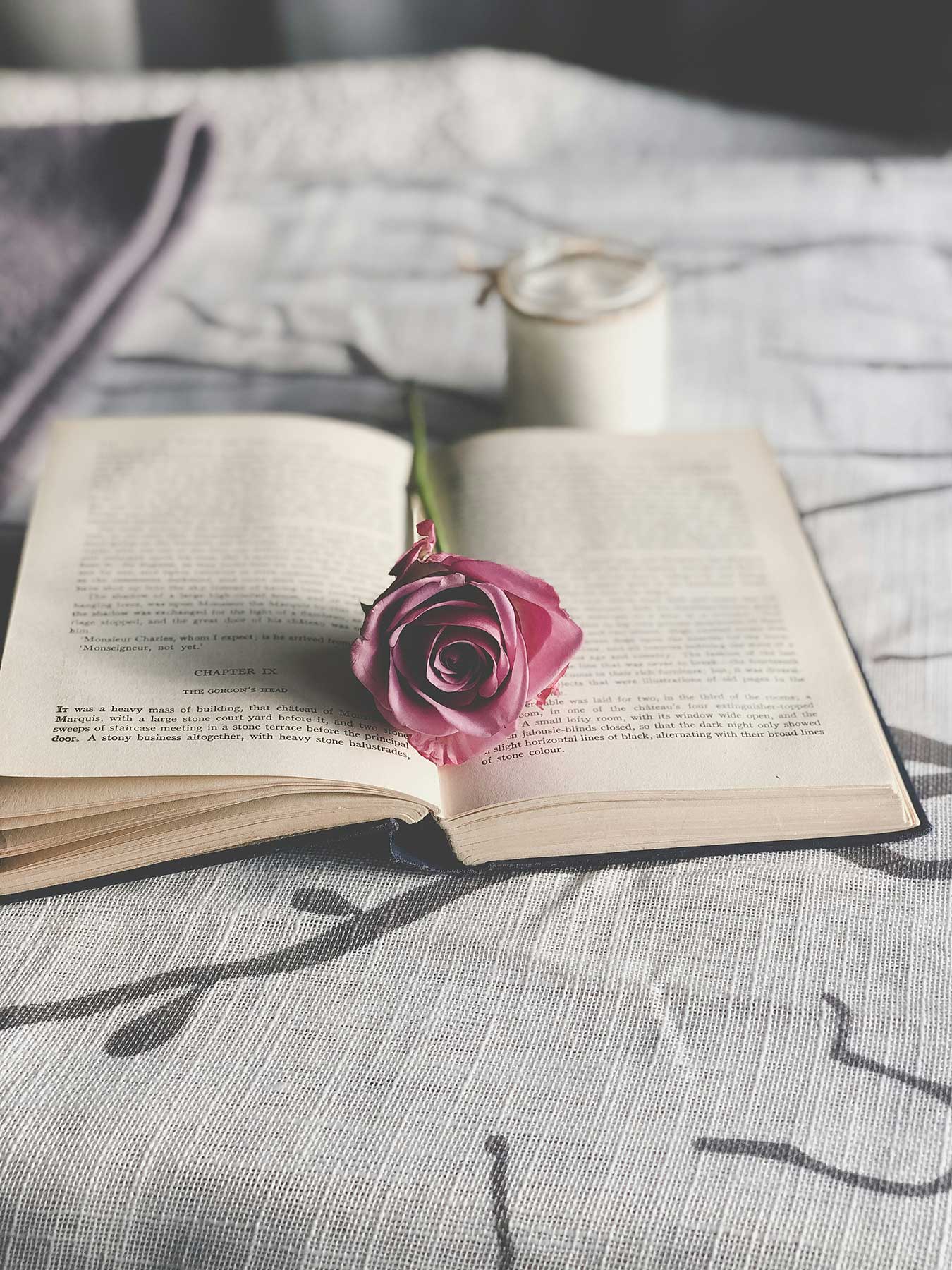
I am sharing this beautiful meditation from one of my favorite meditation masters - Rachel Hillary. This journey will help you connect to the power of your own soul rivaled only by the power of nature.
Rachel will share a little about this experience -
This meditation is set in a beautiful ethereal rose garden at sunset.
For healing, harmony, heart expanding, pink lemonade deliciousness and purple kisses.
Allow this gentle journey to carry you to the most loving place conjured within.
lots of love,
Rachel
Each month we will have a positive affirmation. I recommend you print out this affirmation and put it in your sketchbook or somewhere in your studio. Recite the affirmation out loud each time you show up to create. Saying words aloud is powerful and can begin to re-write some of our own limiting beliefs or calm our fears. Try it now…
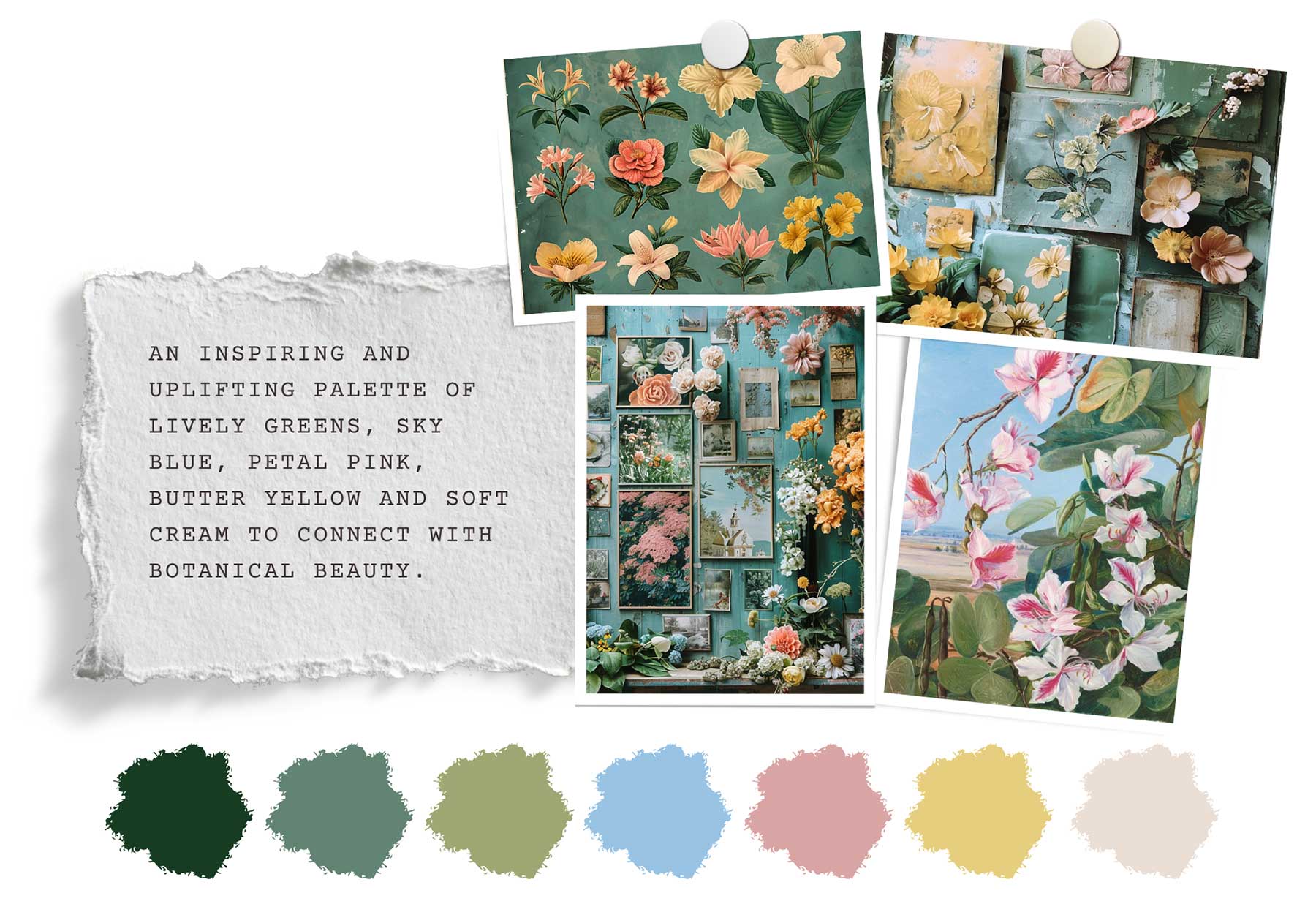
In this issue, we embark on a journey of renewal and awakening, guided by the transformative power of nature and the boundless creativity it inspires. Our chosen color palette mirrors the essence of this journey, drawing from the vibrant tapestry of spring—a season of growth, rebirth, and boundless possibilities.
Emerald Green: whispers the secrets of ancient forests and new leaves, reminding us of nature's cyclical renewal and the fresh starts available to us.
Soft Pink: captures the tender beginnings of floral blooms, embodying hope and the gentle touch of inspiration caressing our creative spirits.
Buttercup Yellow: beams with the joy and optimism of sunlight through the canopy, illuminating our path forward with clarity and warmth.
Sky Blue: offers a breath of fresh air, expansive and serene, inviting us to dream big and reach beyond our current horizons.
Soft Taupe: grounds us, a solid foundation from which our artistic endeavors can flourish, rooted in the nurturing soils of Mother Earth.
Together, these colors weave a narrative of awakening—encouraging us to open our eyes to the beauty around and within us, to nurture our creative seeds into full bloom, and to embrace each moment of our journey with joy and gratitude. Let this palette be your guide as you explore the boundless landscapes of your creativity, inspired by the natural world's enduring wisdom and beauty.
In this issue, we spotlight Marianne North, a trailblazing Victorian artist and explorer whose legacy perfectly aligns with our theme of awakening and connection to the natural world. North's unique contribution to botanical art—capturing plants in their natural habitats across the globe—makes her an inspiring figure for our exploration. Her fearless journeys and dedication to her craft challenge us to see the world with fresh eyes and to pursue our creative passions with courage.
Through North's work, housed in the Marianne North Gallery at Kew Gardens, we are invited into a vivid world where art and nature intertwine, reminding us of the beauty that awaits when we dare to explore beyond our boundaries. Let's draw inspiration from her life and art, embracing the possibilities that unfold when we connect deeply with the natural world.
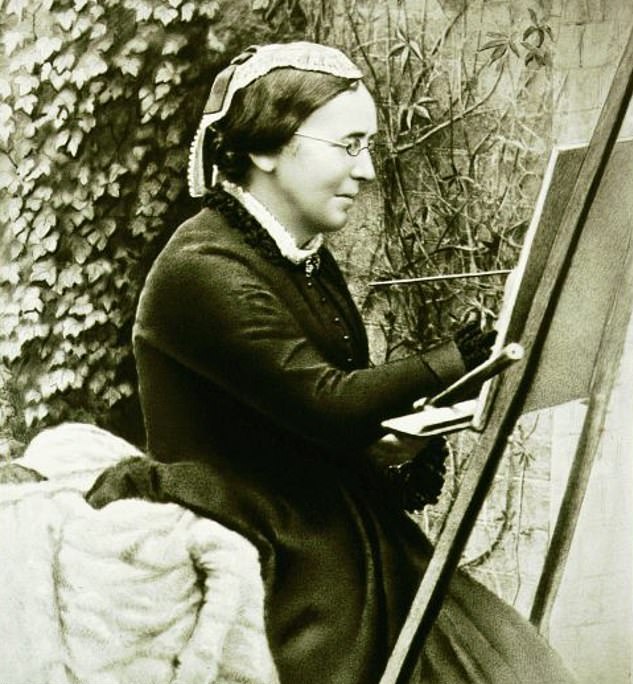
Marianne North, born in 1830 in Hastings, England, was an intrepid explorer and a prolific botanical artist, whose life's work transcends mere painting to embody a profound connection with the natural world. Unbound by the constraints of her Victorian era, North’s dedication to her art and science led her on a fearless journey across the globe, capturing the essence of the world's flora in its raw, unadulterated beauty.
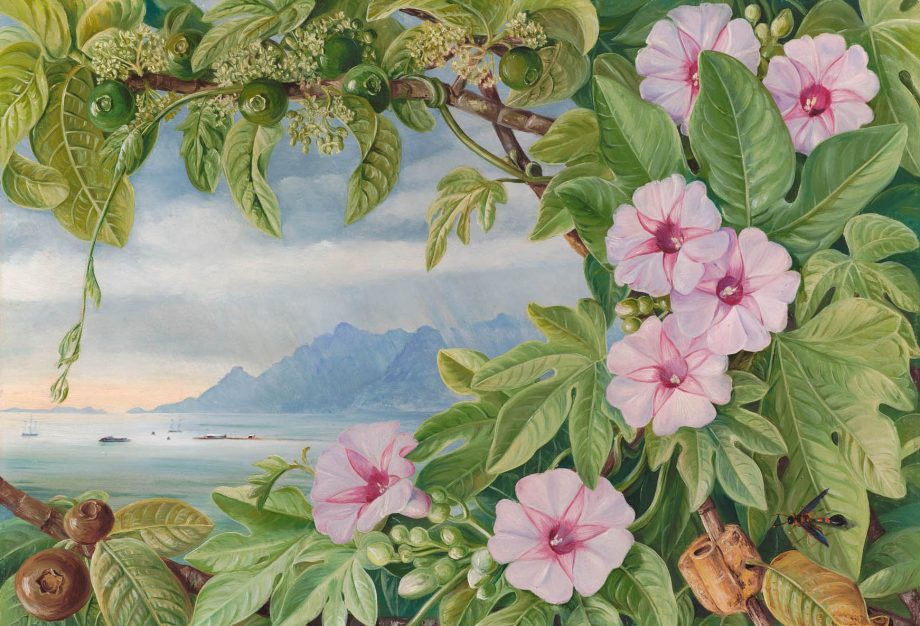
Ipomoea and Vavangue with Mahe Harbour in the distance, painted on Madagascar
Marianne North, 1883
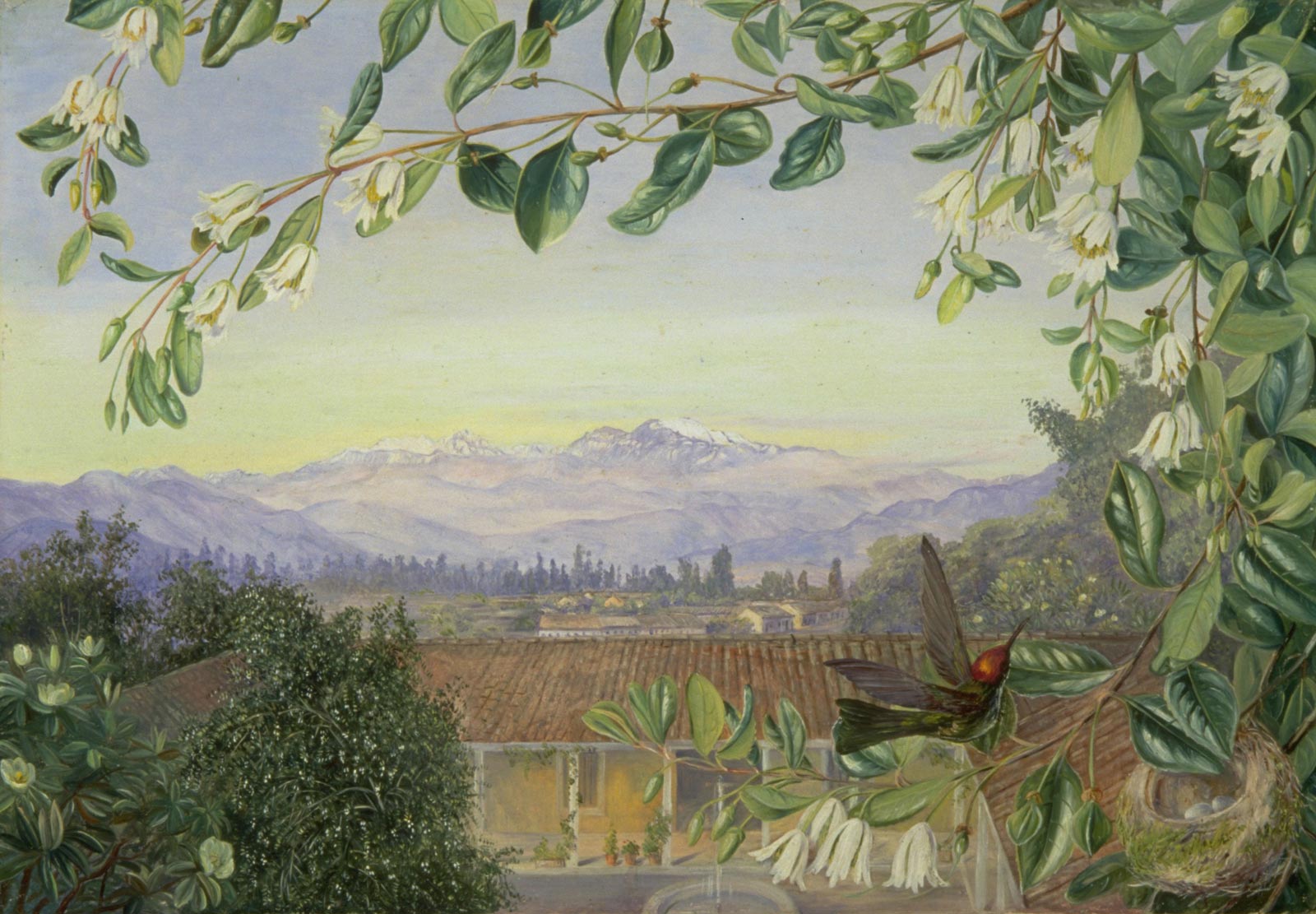
The Permanent Snows, from Santiago, Chile
Marianne North
North's journey began after the death of her father, when she decided to dedicate her life to travel and botanical illustration. Rejecting the traditional role of women in her time, she ventured alone to remote corners of the world – from the jungles of Brazil to the temples of India, the mountains of Japan, and the forests of Australia. Her work resulted in a collection of over 800 paintings, now housed in the Marianne North Gallery at Kew Gardens, London. This gallery, which she insisted on arranging geographically, remains a testament to her vision, offering a window into the lush, vibrant world of 19th-century flora.
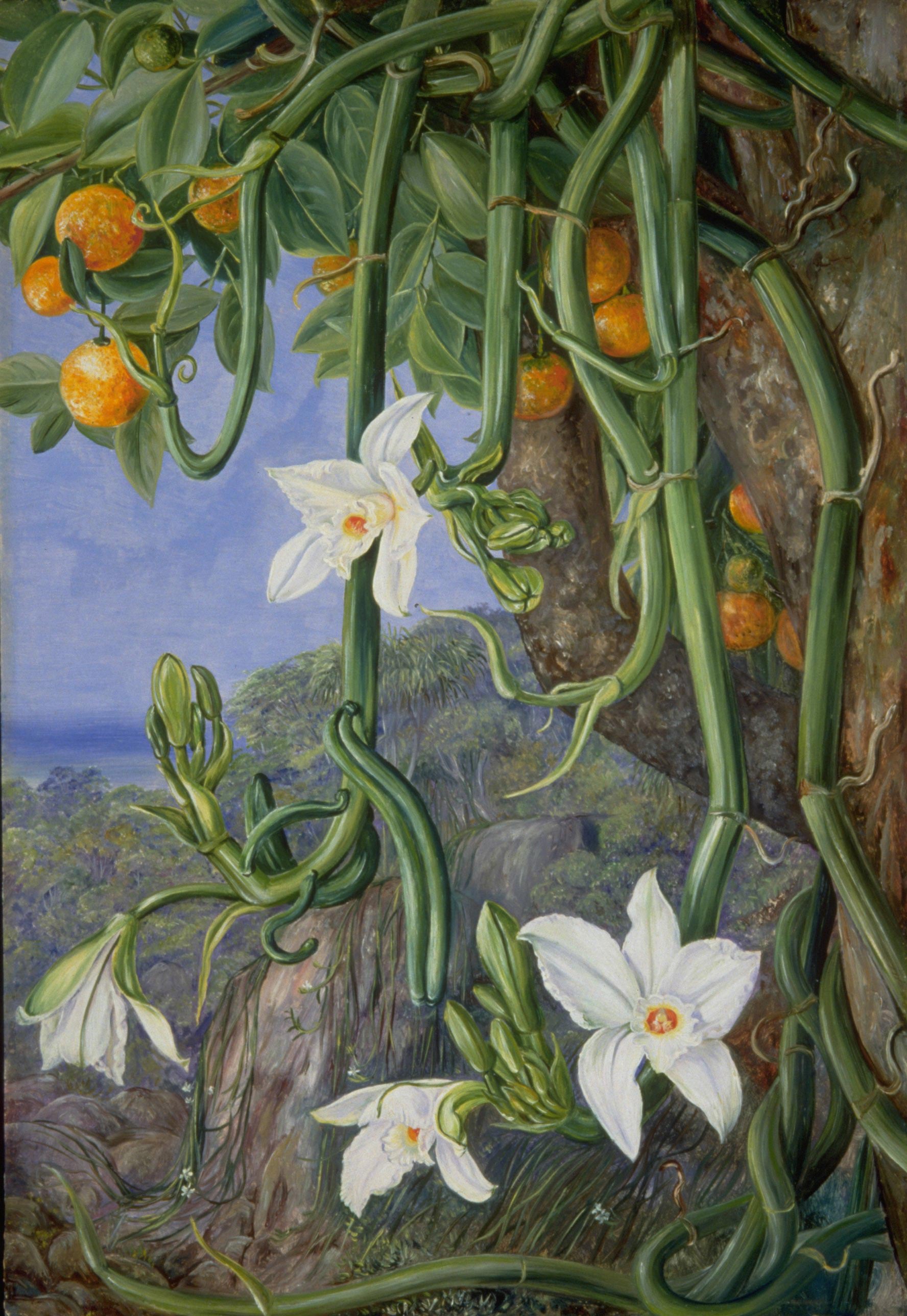
Native Vanilla hanging from the Wile Orange, Praslin, Seychelles
Marianne North
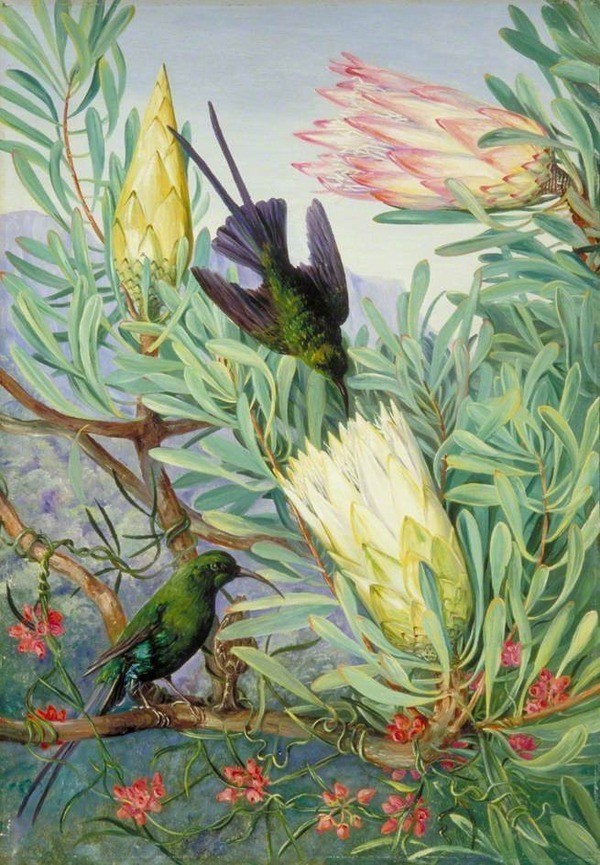
Honeyflowers and Honeysuckers, South Africa
Marianne North
North's travels were remarkable not just for their scope but for their boldness. At a time when women were expected to lead quiet, domestic lives, North traversed dangerous and unknown landscapes, often putting herself at risk to capture a plant's essence. Her keen observation skills were evident in the meticulous detail of her paintings, each a vibrant testament to her ability to see and document the world in a way few others could.
Her dedication to her craft was unparalleled. She worked in challenging conditions, often in the oppressive heat of tropical climates, to paint plants where they grew. This dedication speaks to her profound connection to nature. For North, painting was a way to commune with the natural world, to understand its secrets, and to share its wonders with an audience that might never see them otherwise.
She went beyond breaking the typical female artist's role of her time; she shattered it. By choosing a life of exploration and art over marriage and domesticity, she challenged societal norms and paved the way for future generations of women in science and art. Her legacy is not just in the beauty of her paintings but in the spirit of independence, curiosity, and resilience they embody.
Marianne North's life and work deeply resonate with our theme of awakening through her fearless exploration and keen observation skills. Her dedication and connection to nature were not just about documenting plants but about immersing herself in the ecosystems that nurtured them. North saw her travels and art as a way to awaken a deeper appreciation for the world's natural beauty, striving to share this vision with others. Her paintings are not mere representations; they are an invitation to look closer, to understand the intricate relationships within nature.
Her work and legacy continue to inspire not just artists and scientists but anyone who values the profound connection between humanity and the natural world. In celebrating Marianne North, we celebrate a pioneering spirit that awakens us to the beauty and complexity of nature, urging us to explore, observe, and connect with the world around us in our own creative endeavors.
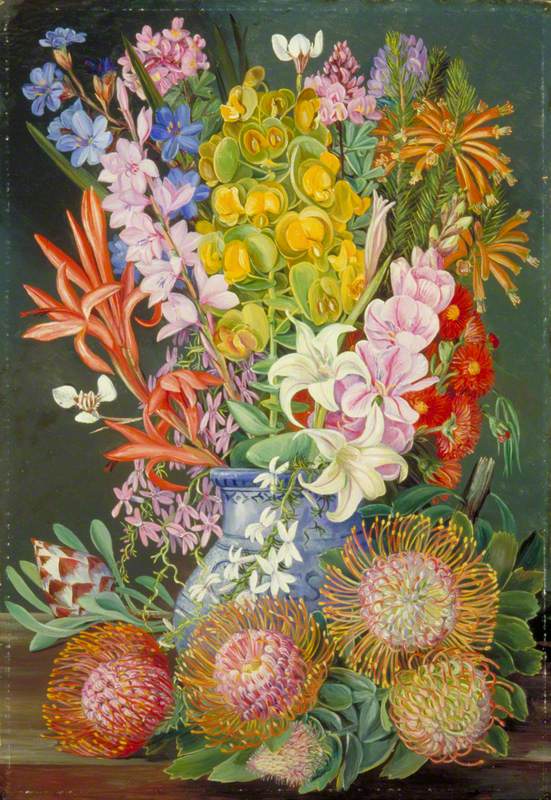
Wild Flowers of Ceres, South Africa
Marianne North, c.1882
Marianne North's painting style, technique, and choice of medium offer a fascinating study in both the scientific and artistic exploration of the natural world, presenting a source of inspiration and connection for us today.
North's approach to botanical art was unique for her time, characterized by a vibrant realism that brought distant landscapes and exotic plants to life for viewers back home. Unlike many of her contemporaries, who often painted flora in isolation, North placed plants in their natural habitats, capturing not just the specimen but the ecosystem it belonged to. This holistic approach allowed her to create more than just botanical illustrations; her paintings are rich, detailed narratives that speak of the plant's place in the world.
Her technique was meticulous and self-taught, developed through years of practice and observation. North preferred working directly from nature, painting in situ rather than from sketches or memory. This direct engagement with her subjects is evident in the immediacy and vibrancy of her work. Her keen eye for detail and color resulted in paintings that are both scientifically accurate and artistically compelling, capturing the essence of the flora she so loved.
She primarily worked in oil paints, a medium that allowed her to achieve the richness of color and texture that characterizes her work. The choice of oil paints was somewhat unusual for botanical illustration, a field that traditionally favored watercolors for their delicacy and precision. However, North's use of oils contributed to the boldness and immediacy of her paintings, setting her work apart and underscoring her independence as an artist. Her dedication to painting in the natural habitat challenges artists to consider the context and environment of their subjects, encouraging a deeper engagement with the world.
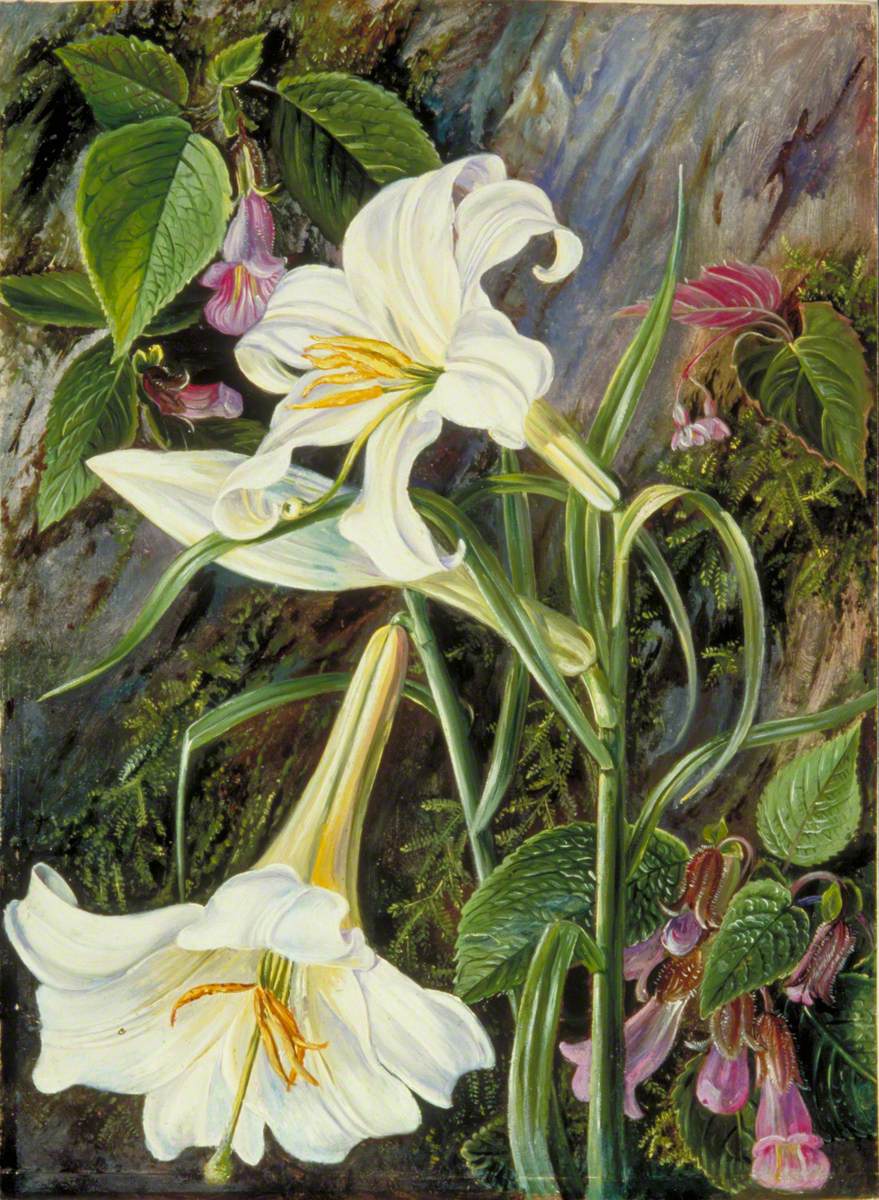
The Great Lily of Nainee Tal, in North India
Marianne North
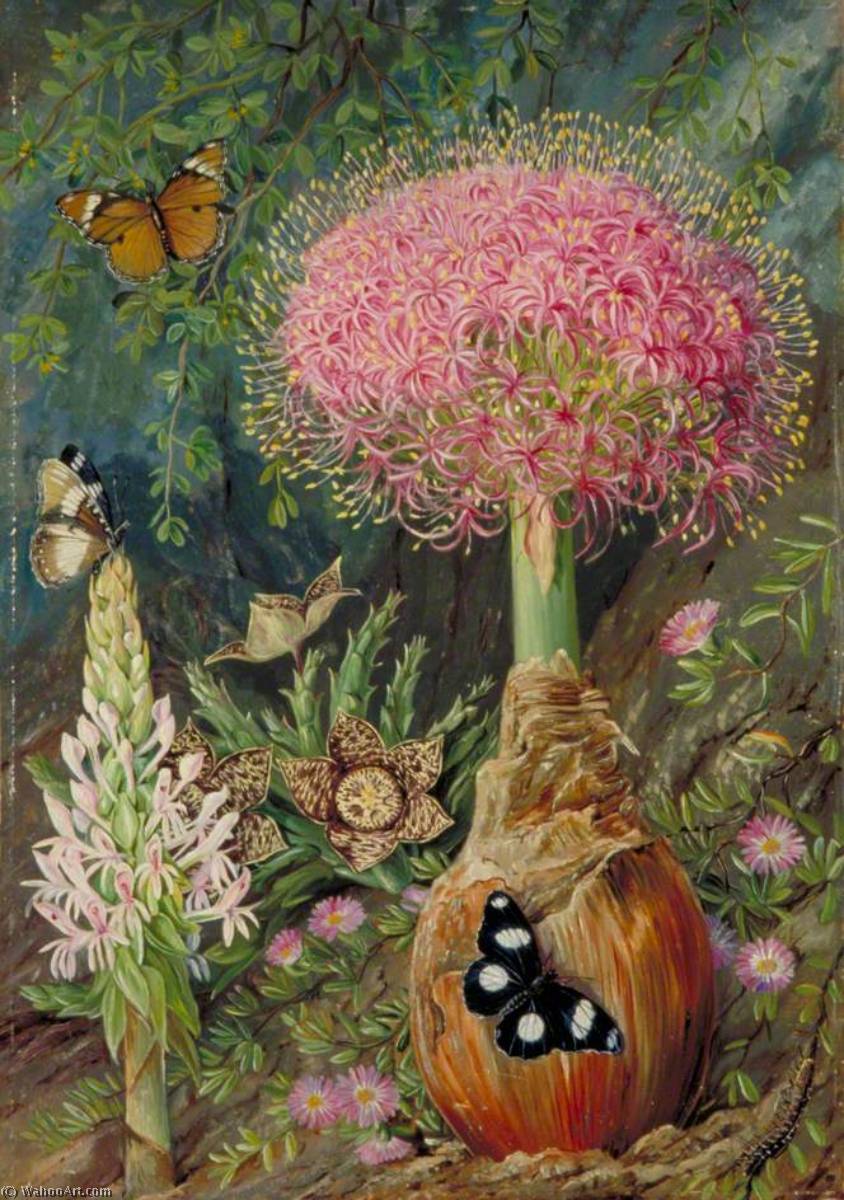
Buphane toxicara and Other Flowers of Grahamstown
Marianne North
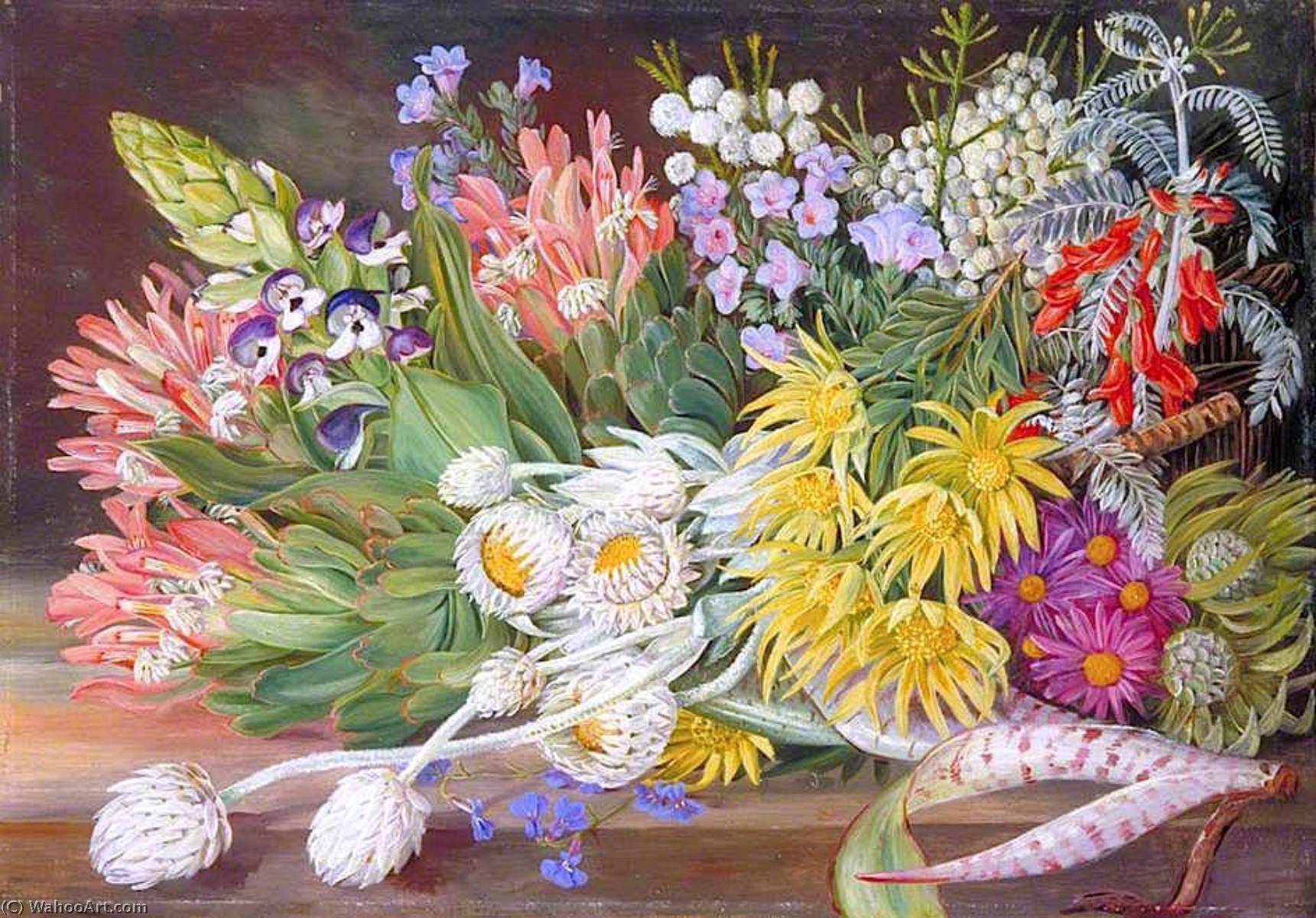
A Medley of Flowers from Table Mountain, Cape of Good Hope
Marianne North
North's self-taught skill and unique approach to botanical art highlight the value of personal vision and the pursuit of one's passions, regardless of conventional expectations or norms. Her choice of medium and technique underscore the importance of experimentation and finding the tools that best express one's artistic intent. In an age where digital technology often distances us from nature, North's paintings invite us to reconnect with the earth and find inspiration in its myriad forms.
In the realm of botanical art, the rich tradition of capturing the intricate beauty of flora has long been revered for its scientific precision and detailed realism. Historical figures like Marianne North have left us a legacy of botanical masterpieces that offer a window into the natural world's diversity and detail. However, as the art world evolves, so too does the approach to depicting nature. Today, artists are exploring botanical subjects with a modern, simplified, and fresh perspective, moving beyond the confines of traditional realism to embrace a more abstract, conceptual, or minimalist aesthetic. Here are three innovative approaches for artists looking to reinterpret botanical art in a contemporary context:
1. Abstract Interpretation
One way to modernize botanical art is through abstraction. This approach involves breaking down plants into their fundamental shapes and colors, moving away from detailed representation to capture the essence of the subject. Artists can focus on the geometric patterns within petals, the organic shapes of leaves, or the vibrant color palettes found in nature. By exaggerating or simplifying these elements, artists create works that, while rooted in the natural world, invite viewers to engage with the subject in a more emotional or intuitive way. Abstraction allows for a playful exploration of form and color, encouraging a personal connection to the botanical world that is open to interpretation.
2. Minimalist Composition
Minimalism in botanical art emphasizes simplicity, space, and a focus on the singular beauty of a plant or flower. By stripping away the background and reducing the subject to its most basic form, artists can highlight the elegance and symmetry inherent in botanical subjects. This approach often employs a restrained color palette and a focus on line and shape, creating a serene, contemplative space that draws the viewer's attention to the subtle details and textures of the plant. Minimalist botanical art can convey a sense of calm and purity, offering a fresh perspective on the natural world through the lens of simplicity and refinement.
3. Mixed Media and Collage
Exploring botanical art through mixed media and collage offers a dynamic, textured approach that can breathe new life into traditional subjects. By combining various materials—such as paper, fabric, photography, and paint—artists can layer elements to create depth and interest. This method allows for the incorporation of non-traditional elements, such as urban or digital motifs, juxtaposing the organic forms of plants with contemporary life. Collage can also involve the use of botanical motifs in unexpected ways, challenging the viewer's perceptions of nature and art. This approach not only modernizes botanical art but also makes it more accessible and relatable to a broader audience.
Conclusion
As artists continue to explore and reinterpret the world around them, botanical art remains a rich source of inspiration. By adopting modern, simplified approaches such as abstraction, minimalism, and mixed media, artists can create fresh, engaging works that resonate with contemporary audiences while still paying homage to the natural beauty that has captivated humans for centuries. These innovative methods offer new ways to appreciate and connect with the botanical world, demonstrating that even the oldest subjects can be seen through new eyes.
Choose a plant or flower that you feel a personal connection to or one that simply catches your eye. Spend time with it in its natural setting, if possible. Observe it closely, noting not just its form and color, but its texture, the way it moves in the breeze, and its relationship with its surroundings. Sketch it from various angles, focusing on capturing its essence rather than creating a perfect replica. Alongside your sketches, jot down any thoughts, emotions, or memories that arise during this process. Reflect on how this focused observation affects your connection to the natural world and your inner self.
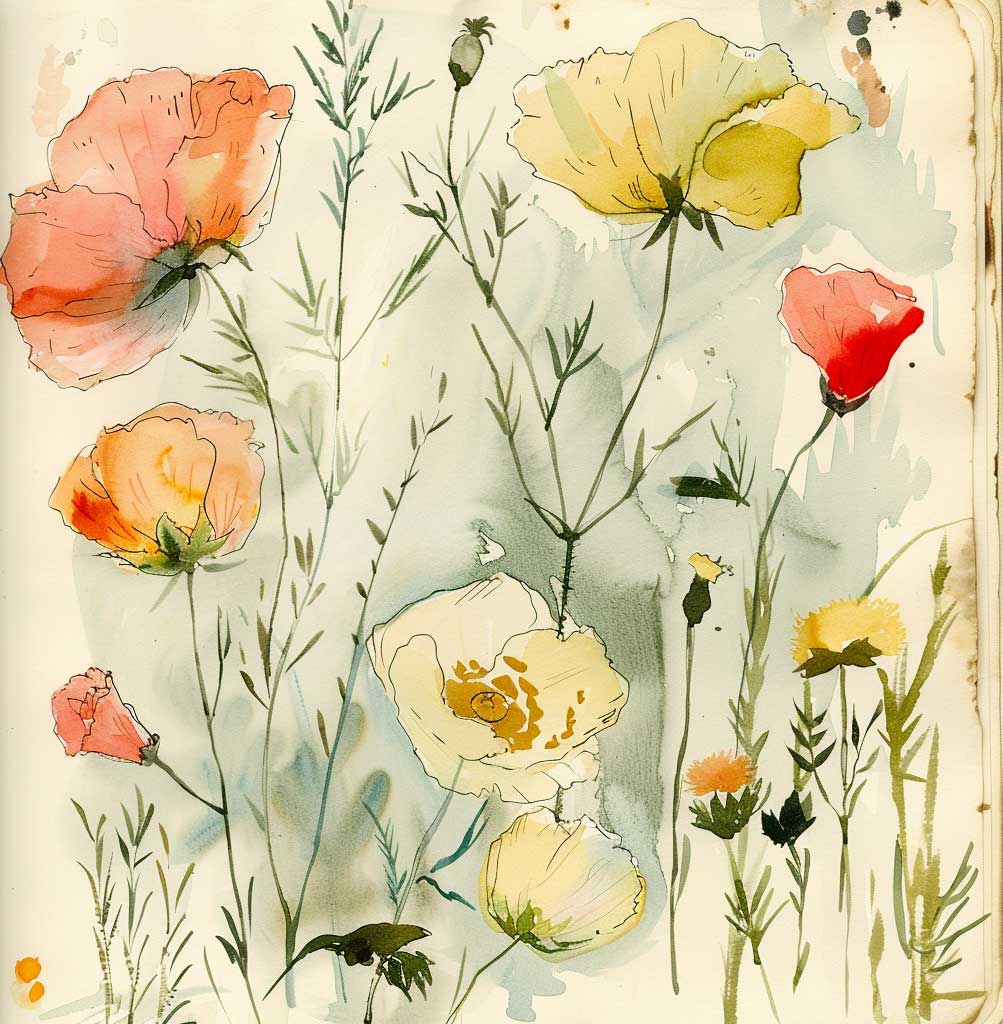
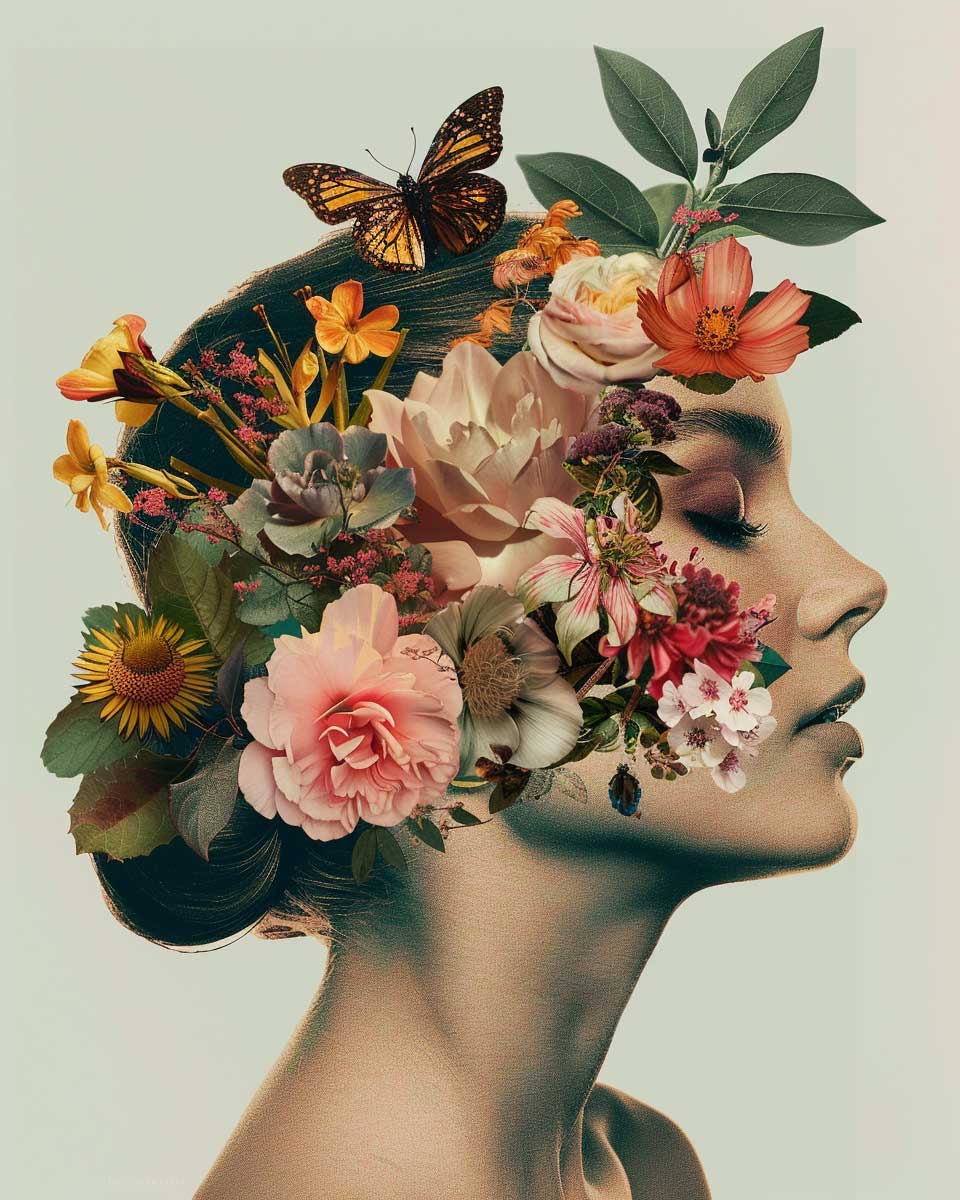
Create a captivating collage in your sketchbook combining the elegance of flowers with the silhouette of a woman's profile. Start with a simple outline of a woman’s head and then fill or embellish it with various botanical elements from magazine cutouts, patterned paper, or photographs. Let the natural shapes and colors of the flowers blend seamlessly with the lines of the profile, transforming it into a vibrant celebration of nature and femininity. Once your collage is set, add any desired details with markers or paint to bring your artwork to life. Reflect on the interplay between the botanical elements and the human form, and what this fusion signifies to you.
Dive into the detailed world of Marianne North and select a painting that speaks to you. Study its composition, colors, and the intricate beauty of its botanical subjects. Then, challenge yourself to distill these elements into a modern, abstract form. Whether it’s through bold, simplified shapes, minimalist lines, or a creative collage, transform North’s realism into a piece that echoes her natural themes through your contemporary lens. Utilize your favorite mediums and techniques to bring this vision to life, blending North’s meticulous observation of nature with your unique, modern artistic voice. Reflect on how this process allows you to connect with North’s work in a new way, creating a bridge between her historical accuracy and your personal expression in the present day. This exercise is not just about artistic innovation, but also about paying homage to North’s legacy in a manner that resonates with today’s creative explorations.
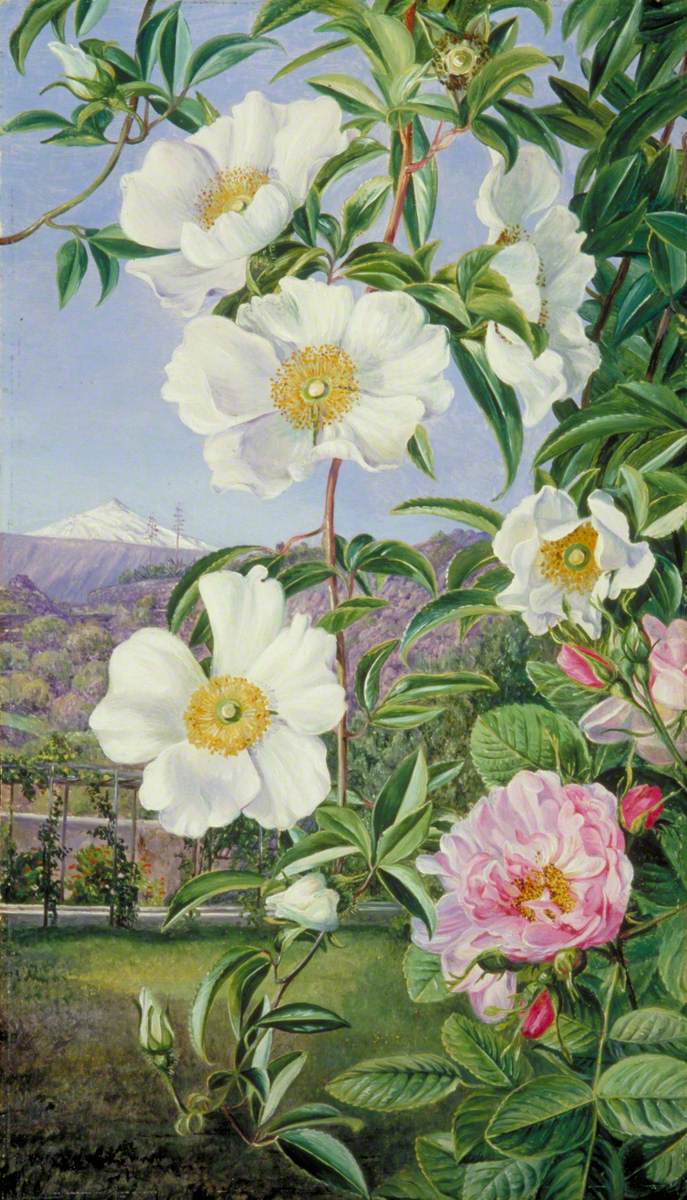
Now that we've explored the legendary cafés of Paris, Vienna, and beyond, I thought Yvonne's beautiful lesson, Sketching in a Coffee Shop, would be a perfect way to end this month's Studioworks Journal!
This lesson is designed to empower you to take that significant step: sketching in public. While the idea might seem daunting at first, we'll ease into it by focusing on sketching objects, making the experience enjoyable and far less intimidating.
Join Yvonne as we sketch along together, and venture outdoors to experience the exhilaration of sketching in the open air. Yvonne will share how she prepare for a sketching session in a coffee shop, from selecting the perfect spot to capturing the essence of the view that captivates her, all while guiding you through the process of creating dynamic sketches directly with a fine line pen.
You can also listen to this month’s issue of the Studioworks journal. I find I love listening to books, podcasts and music while I draw, paint or go on a long walk. Enjoy.

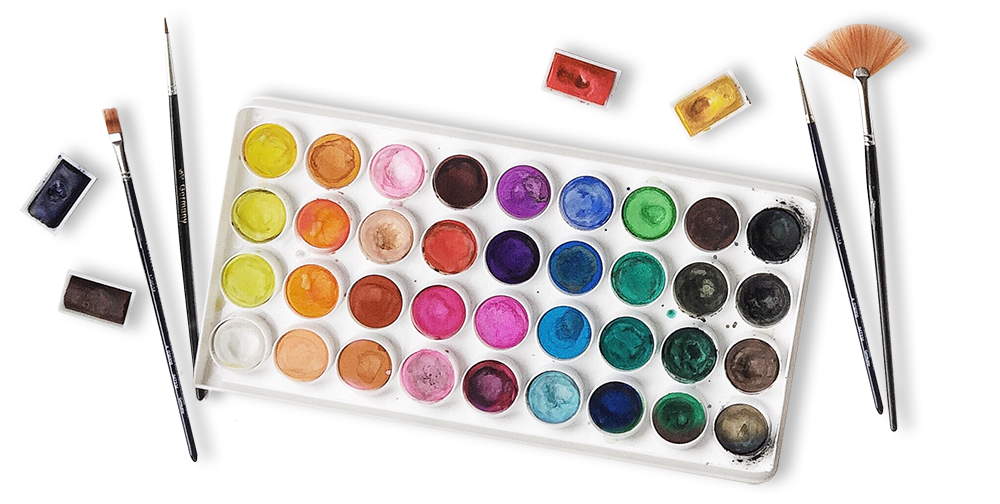
One of my favorite things to do is to curate inspiration. From Pinterest boards to books, resources, playlists and more - I love to share anything that might facilitate learning, expansion, and sparks of curiosity! Being an artist, we naturally crave these things so here are some of this month’s picks from me to you.
I had so much fun curating this list. I hope you enjoy!!
Here are just a few of our fantastic classes! I highly recommend checking them out if you haven’t already. Enjoy!